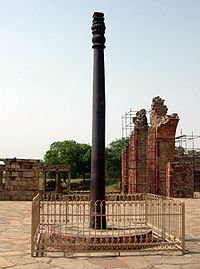The 1600 Years Old Rust Free Iron Pillar Of Delhi
Hi Steemians! I want to share every moment I experience here on Stemmit.
The iron pillar of Delhi is a 7 m (23 ft) kirti stambha (column of distinction or victory segment), initially raised and devoted as dhvaja(banner) to Hindu divinity lord Vishnu in third to fourth century CE by king Chandragupta II , as of now remaining in the Qutb complex at Mehrauli in Delhi, India.[1] It is well known for the rust proof structure of the metals utilized as a part of its development.
The column has pulled in the consideration of archaeologists and materials scientistsbecause of its high obstruction to corrosionand has been known as a "declaration to the abnormal state of expertise accomplished by the old Indian iron smiths in the extraction and handling of iron."[2][3] The erosion opposition comes about because of an even layer of crystalline iron hydrogen phosphate hydrate forming on the high-phosphorus-content iron, which serves to shield it from the impacts of the Delhi climate.[2]
The column weighs more than 6,000 kg (13,000 lb) and is thought to have initially been raised in what is now Udayagiri by one of the Guptamonarchs in roughly 402 CE, however the exact date and area involve dispute.[4]
The column was produced by the forge welding of pieces of wrought press. In a report distributed in the journal Current Science, R. Balasubramaniam of the IIT Kanpur explains how the column's protection from consumption is because of a passive defensive film at the iron-rust interface. The nearness of second-stage particles (slag and unreduced iron oxides) in the microstructure of the iron, that of high measures of phosphorus in the metal, and the substitute wetting and drying existing under barometrical conditions are the three principle factors in the three-organize arrangement of that defensive latent film.[32]
Lepidocrocite and goethite are the principal undefined iron oxyhydroxides that show endless supply of iron. High erosion rates are at first watched. At that point, a basic synthetic response intercedes: slag and unreduced iron oxides (second stage particles) in the iron microstructure change the polarization qualities and advance the metal– scale interface with phosphorus, subsequently in a roundabout way promoting passivation of the iron[33](cessation of rusting movement). The second-stage particles go about as a cathode, and the metal itself fills in as anode, for a small scale galvanic consumption response amid condition presentation. Some portion of the underlying iron oxyhydroxides is likewise changed into magnetite, which fairly backs off the procedure of erosion. The continuous decrease of lepidocrocite and the dissemination of oxygen and reciprocal erosion through the breaks and pores in the rust still add to the consumption system from climatic conditions.

upvote for me please? https://steemit.com/news/@bible.com/2sysip
nice great work buddy
keep supporting!!
https://steemit.com/mgsc/@rajatgaur/russia-s-first-crypto-investment-bank